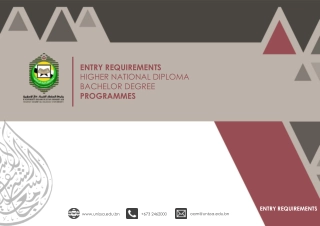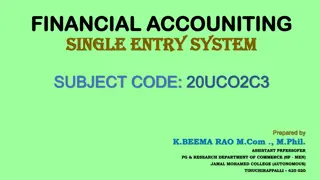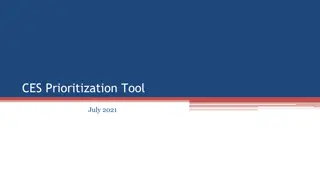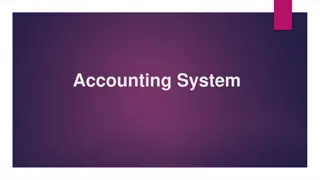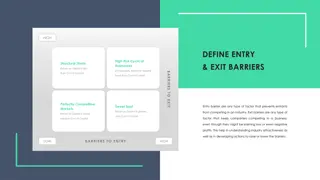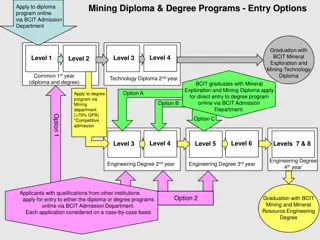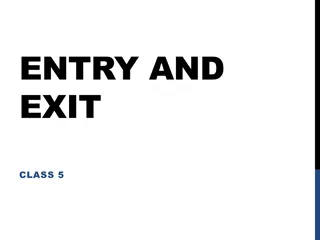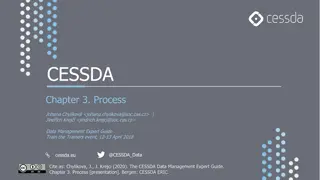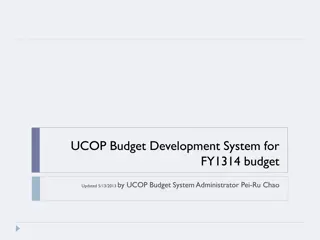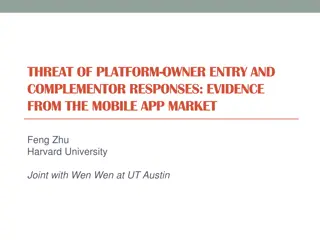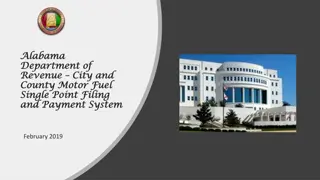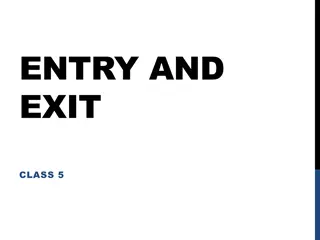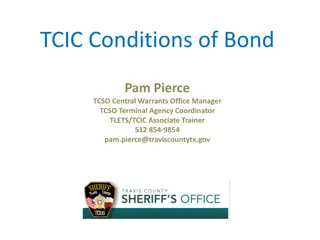SINGLE ENTRY SYSTEM
In single entry system, only one aspect of business transactions is recorded, leading to incomplete books of accounts with limited information. It is suitable for small businesses but lacks the accuracy and comprehensive analysis provided by double entry system. While simple and cost-effective, it poses risks of misappropriation and inaccuracies.
Download Presentation

Please find below an Image/Link to download the presentation.
The content on the website is provided AS IS for your information and personal use only. It may not be sold, licensed, or shared on other websites without obtaining consent from the author.If you encounter any issues during the download, it is possible that the publisher has removed the file from their server.
You are allowed to download the files provided on this website for personal or commercial use, subject to the condition that they are used lawfully. All files are the property of their respective owners.
The content on the website is provided AS IS for your information and personal use only. It may not be sold, licensed, or shared on other websites without obtaining consent from the author.
E N D
Presentation Transcript
Meaning Under Double Entry system of book-keeping both the aspects of each and every transaction are recorded. However, in Single Entry system of accounting both the aspects of business transactions are not recorded in the books of accounts. Only one aspect of the transaction i.e. personal is recorded and the other aspect is ignored.
For example, If goods are sold to customers on credit, then only customer s account will be debited. Goods account will not be credited. Such a system of accounting is called Single Entry system of accounting. Under this system, only the accounts which are absolutely necessary are maintained. Other accounts i.e. nominal and real accounts are not maintained except the cash account. All customer s and creditor s accounts are maintained. As all the accounts are not maintained, it is possible that some transactions may not be recorded at all. Therefore, under Single Entry system, the books of accounts are incomplete and cannot provide the correct results and information.
Features 1) Only sole trader and partnership organizations may keep their books of accounts under this system. 2) Under this system only cash and personal accounts are kept 3) Cash book may contain proprietor s business as well as personal transactions. 4) For getting factual information, it will be necessary to refer to the original documents. 5)There is no uniformity in maintenance of accounts. 6) Only one aspect of the transaction is recorded.
Advantages It is a most simple method of recording business transactions. Maintenance of accounts does not require adequate knowledge of the principles of book-keeping. It is less costlier than double entry book keeping. Determination of profit or loss is much easier. It is suitable to small concerns having limited number of transactions and a few assets and liabilities.
Disadvantages It is not a scientific method-Arithmetical accuracy of accounts cannot be checked as Trial Balance cannot be prepared. This system gives scope for misappropriations and frauds. Trading account cannot be prepared as Goods accounts are not maintained. Thus, Gross Profit cannot be ascertained. Profit and loss account also cannot be prepared as the accounts of expenses and income are not prepared. Hence profit and loss cannot be directly ascertained. Balance sheet cannot be prepared directly as real accounts and other accounts are not maintained. In the absence of final accounts it becomes difficult to know the exact financial position of the business. Tax returns may not be correct.
Difference between single entry and double entry system Double entry Single entry Both the aspects of each transaction are recorded Both the aspects of each transaction are not recorded It is complete, satisfactory and scientific system It is incomplete, unsatisfactory and unscientific system It is possible to prepare trial balance It is not possible to prepare trial balance Arithmetical accuracy of books of accounts can be verified Arithmetical accuracy of books of accounts cannot be verified All types of accounts are kept Generally personal accounts and cash accounts are kept It is possible to prepare profit and loss accounts and balance sheet easily It is difficult to prepare profit and loss accounts and balance sheet easily In balance sheet the values of assets and liabilities are taken from ledger In statement of affairs the values of assets and liabilities are taken by physical inspection and on the basis of estimates.
Methods of computing profit and loss when the accounts are kept under single entry system: 1. statement of Affairs method:- Under this method, prepare statement of affairs:- at the beginning of the year, and at the end of the year, to ascertain the amount of capital at the beginning of the year and at the end of the year.
While preparing statement of affairs at the end, the value of assets should be shown as under:- 1. Fixed Assets---- cost less depreciation and after adjustment for profit & loss for sale of asset. 2. Debtors----------- after adjusting bad debts, RDD and discount on debtors 3. Stock -------------- physical counting. 4. Outstanding/prepaid expenses or income :- as per actual data. 5. cash on hand------ as per physical count and cash book. 6. Bank balance------- as per cash book or pass book, if cash book is not maintained. 7. loan taken/given----- as per actual data.
After preparing both the statements of affairs, and computing opening and closing balance of capital. Next step is to find out profit or loss for the year. This can be ascertained as follows:- Statement of Profit/Loss:- Capital at the end of the year--------------------------------------------- Add:- Drawings made during the year in cash and goods------------ xxx xxx xxx xxx xxx xxx Less:- Additional capital introduced Less:- Capital at the beginning Profit xxx
Machinery A/c Date Particulars Amount Date Particulars Amount 1/1/13 To Bank (4000x40) 1,60,000 31/12/13 By Dep 30,000 To Bank 80,000 By Balance c/d 2,70,000 To Bank 60,000 3,00,000 3,00,000 1/1/14 To balance b/d 2,70,000 31/12/14 By dep Machine I 60,000 To Bank 1,00,000 By dep machine II 20,000 By Balance b/d 2,90,000 3,70,000 3,70,000 1/1/15 To Balance b/d 2,90,000 1/7/15 By Bank (Sale) 34,800 By P and L (loss) 25,200 By Dep (Mac sold) 10,000 31/12/15 By dep Mac I 40,000 By Dep Mac II 20,000 By Balance c/f 1,60,000
Method of Depreciation Annuity Method : Under this method depreciation is charged after taking into account the interest lost on investment in the asset and calculated from annuity tables. Firstly the interest is debited to asset account at the fixed rate of interest and credited to interest account. Features: 1) It recognizes the time value of money 2) The annuity table facilitates the computation of annual depreciation 3) Every year same amount of depreciation is charged
Machine hour rate method Under this method life of the asset is fixed in terms of hours. In this method an hourly rate of depreciation is found by dividing cost of the asset by total number of hours for which the machine is expected to be used. The dep. to be written off in a year ascertained by multiplying the hourly rate of depreciation by number of hours that machine has actually run in a year. Machine hour rate= Cost of Machine/Estimated total life
Service hour rate method Under this method the running time of asset is taken into account for calculation of depreciation. For example Estimated life of aircraft is determined in terms of hours. The formula for calculation R= C-S/N
Depletion Method Depletion method is used in respect of asset such as mines, quarries from which certain quantity of output is expected to be generated Rate of depreciation = Cost/ estimated Output
Revaluation Method Under this method, the asset is revalued at the end of accounting year. This value is compared with the value of asset at the beginning of the year. The difference between two is treated as depreciation
Sum of the Digit Method This method has been invented by American Accountants. In this method depreciation to be charged constantly reduces Depreciation = Amount to be written off ------------------------------------ X Number of years remaining of the asset including current year Total of all the digit representing the life of the asset Cost of machine 1,00000 Life = 3 years Dep. in first Year= 1,00,000 ------------ X 3 3+2+1 = 50,000
Single Entry system A system of book keeping in which only one records of cash and personal accounts are maintained, it is always incomplete double entry, varying with circumstances. Features: 1) Only sole trader and partnership may keep their books of accounts under this system 2) Joint stock companies cannot keep their accounts as per this system 3) Under this system, only cash and personal accounts are kept, impersonal and other accounts are not maintained 4) Under this system only one aspects of transaction is recorded
Drawbacks Arithmetical accuracy Scope for misappropriation Trading account cannot be prepared B/S Profit and loss account cannot be prepared Difficult to know the exact financial position Sale of business- difficult to determine Purchase Consideration Tax returns will not be correct
Conversion method Under conversion method an attempt is made to prepare complete final accounts from available records by first completing double entry to the extent possible. This process requires preparation of control accounts. For preparation of accounts, following will be necessary Trading and Profit and Loss Accounts Balance sheet Debtors Accounts Creditors Accounts Statement of Affairs
Statement of Affairs a/c Liabilities Assets Sundry Creditors Fixed Assets Bills Payable Sundry Creditor Outstanding expenses Bills Receivable Bank O/D Stock Capital (Balancing Figure) Investment Cash in hand and at Bank


